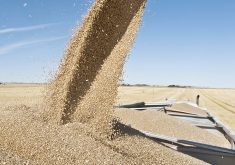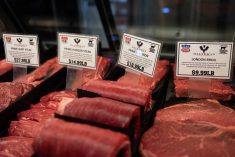Fed cattle static
Prices were virtually unchanged in the low $70s per hundredweight last week, said Canfax.
The Canadian market reflected the uncertainty in the U.S. market as it awaited firm news on the two inconclusive BSE tests. In the end, both cases were confirmed negative.
Also, Canadian packers continue to own lots of inventory, reducing their interest in bidding. By midweek, bids were difficult to come by with packers mostly passing on newly offered cattle.
The volume was slightly more than 13,000 head, down from the 21,000 that traded the week before.
Read Also

Soybean market still figuring out implications of China-U.S. pact
Soybean futures had a muted reaction to the U.S. trade deal with China as the market tries to figure out the nuances of the deal.
Canfax closed its sales volumes as of June 30 due to the Canada Day holiday. The week’s shorter kill didn’t help the inventory versus capacity situation, said Canfax.
Alberta prices June 30 were steers $70-$71.25 per cwt., flat rail $118-$123 and heifers flat rail $118-$123.
Beef movement is considered fairly good, said Canfax.
U.S. cutouts were mixed with the Choice down about $1 US and the Select up $1.50.
In Canada, cutouts were $5 Cdn or more lower as large kills met some price resistance. All cuts and trim saw price declines.
Wholesale carcass prices are steady for next week with Montreal at $140-$142 and Calgary at $133-$136.
The federally inspected kill two weeks ago was near 74,000 head but was smaller last week due to the holiday.
Steer prices dip
Alberta auction market volumes held steady with slightly more than 8,000 head trading.
Steers were under pressure, while heifers were steady to slightly stronger on lighter volumes.
Steers 400-500 lb. were down $1.25 per cwt., 500-600 lb. traded 75 cents lower, and 600-900 lb. were down $1.25.
Steers 900 lb. and heavier saw the most pressure, falling $5.
Heifers traded 75 cents-$1.75 stronger.
D1, 2 cows were steady, averaging in the low $20s per cwt. Butcher bulls also traded steady.
The small volume of trade appears to be supporting overall feeder prices, said Canfax. Volumes are not expected to pick up for at least another month. But the industry remains nervous about the future and that could cause volatility, depending on the day and the buyer depth.
D1, 2 cows are expected to hold steady.
Stock bred cows in central and northern Alberta traded at $340-$510, while bred heifers in northern Alberta traded for the same money.
Cow-calf pairs were $300-$600 on medium quality and $600-$1,085 on good quality.
Hogs
U.S. cash hog prices decreased about three percent from the week before, reflecting slightly lower wholesale cut-out prices. The Iowa-Minnesota daily direct hog price (plant mean, 51-52 percent, lean carcass converted to live weight) steadily decreased throughout the week from $60.29 US per cwt. to $58.62 per cwt. on July 1. Manitoba hog prices were steady with the week before.
Sheep
Ontario Stockyards reported 2,985 sheep and lambs and 403 goats traded. Light grain-fed lambs sold barely steady, while plainer types traded under extreme pressure.
Heavy lambs, sheep and goats held steady.














